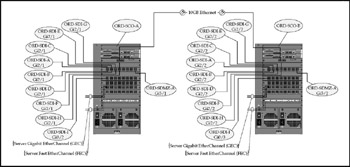

The IETF proposed loop-free alternate (LFA) IP fast reroute technology to speed up failovers. Conventionally, an IP network running the OSPF protocol takes a long time to converge after a failure occurs. Even though a Fibbing network is capable of flexible routing, methods to achieve fast failure recovery have not been well studied. Although the routers still follow the shortest path routing in the virtual network, the flows are steered along the desired paths in the physical network. These fake nodes enlarge the physical topology and turn the network into a virtual network. In a Fibbing network, the network controller cleverly broadcasts link state advertisements (LSAs) of the open shortest path first (OSPF) protocol to generate fake nodes. The prototype demonstrates that BIER-FRR reduces the protection time for BIER traffic to the protection time for unicast traffic in the routing underlay.įibbing is a network technology that can provide flexible routing in IP networks. Third, we propose a controller hierarchy with local controllers for local tasks, in particular to enable IP-FRR and BIER-FRR. It is based on the programmable data plane technology P4. Second, we describe a prototype for BIER and BIER-FRR within an IP network with IP fast reroute (IP-FRR). In particular, BIER-FRR enables BIER to profit from FRR mechanisms in the routing underlay. First, we propose a novel fast reroute (FRR) mechanism for BIER (BIER-FRR) so that IPMC traffic can be rerouted as soon as the routing underlay is able to carry traffic again after a failure. The contribution of this work is threefold. With BIER, core networks do not require dynamic signaling and support a large number of IPMC groups with large churn rates. It offers a transport layer for other IPMC traffic, keeps core routers unaware of IPMC groups, and utilizes a routing underlay, e.g., an IP network, for its forwarding decisions.

The prototype experiments of this real network implementation further confirm the efficiency of BOND.īit Indexed Explicit Replication (BIER) is a novel IP multicast (IPMC) forwarding paradigm proposed by the IETF. Further, we implement BOND with five HUAWEI S5720 SDN switches, two Dell end hosts and a RYU controller. The results show that compared with Multi-Protocol Label Switching (MPLS) Fast Reroute (FRR), BOND consumes an order of magnitude less memory to achieve the same network recovery goal. To demonstrate the efficiency of BOND, we construct comprehensive experiments with real-world topologies.

Secondly, we accelerate the failure recovery with a global hash table and precisely select backup paths to avoid potential congestions in the post-recovery network. Firstly, we allocate backup rules, instead of backup paths, to forwarding switches with flows’ requirements considered. In this paper, we propose BOND, a flexible failure recovery system in SDNs. However, they are generally unpractical for deployment, since they ignore either the failure recovery requirements of different flows or the constrained resources (e.g., flow tables) of SDN switches. To guarantee the network availability in SDNs, some delicate schemes and algorithms have been proposed to pre-compute and set up the backup paths for potential network failures.
Eigrp ip fast reroute software#
We then present a taxonomy of the state of the art, summarize the main lessons learned, and propose a few concrete future directions.įailure recovery has been a hot potato in the maintenance of networks, including software defined networks (SDNs), for many years. We examine the evolution of fast-recovery standards and mechanisms over time, and identify and discuss the fundamental principles and algorithms underlying different mechanisms. This survey presents a systematic, tutorial-like overview of packet-based fast-recovery mechanisms in the data plane, focusing on concepts but structured around different networking technologies, from traditional link-layer and IP-based mechanisms, over BGP and MPLS to emerging software-defined networks and programmable data planes. While reactions to failures in the data plane can be significantly faster compared to control plane mechanisms, implementing fast recovery in the data plane is challenging, and has recently received much attention in the literature. In order to meet their stringent dependability requirements, most modern packet-switched communication networks support fast-recovery mechanisms in the data plane.


 0 kommentar(er)
0 kommentar(er)
